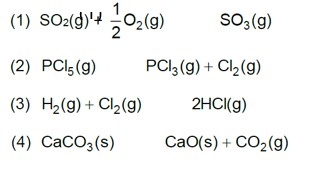7.90 A reddish colour appears on adding two drops of 0.002 M potassium thiocynate solution to 1 mL of 0.2 M iron(III) nitratesolution due to the formation of [Fe(SCN)]2+. Elaborate on the development of the reddish colour.
7.90 A reddish colour appears on adding two drops of 0.002 M potassium thiocynate solution to 1 mL of 0.2 M iron(III) nitratesolution due to the formation of [Fe(SCN)]2+. Elaborate on the development of the reddish colour.
-
1 Answer
-
The intensity of the red colour becomes constant on attaining equilibrium. This equilibrium can be shifted in either forward or reverse directions depending on adding a reactant or a product. The equilibrium can be shifted in the opposite direction by adding reagents that remove Fe3+or SCN– ions. For example, oxalic acidH2C2O4), reacts with Fe3+ ions to form testable complex ion [Fe (C2O4)3]3–, thus decreasing the concentration of free Fe3+ (aq).In accordance with the Le Chatelier's principle, the concentration stress of removed Fe3+ is relieved by dissociation of [Fe (SCN)]2+ to replenish the Fe3+ions. Because the concentration of
...more
Similar Questions for you
0.01 M NaOH,
M = 1 * 10-2

pOH = 2
pH = 2
Kp = Kc (RT)Dng
36 * 10–2 = Kc (0.0821 * 300)–1
Kc = 0.36 * 0.0821 * 300 = 8.86 » 9
A(g) ->B(g) + (g)
Initial moles n 0 0
Eqb. moles n(1 – a) na
total moles =
Eqb. pressure
On increasing pressure, equilibrium moves in that direction where number of gaseous moles decreases.
Taking an Exam? Selecting a College?
Get authentic answers from experts, students and alumni that you won't find anywhere else
Sign Up on ShikshaOn Shiksha, get access to
- 65k Colleges
- 1.2k Exams
- 679k Reviews
- 1800k Answers


